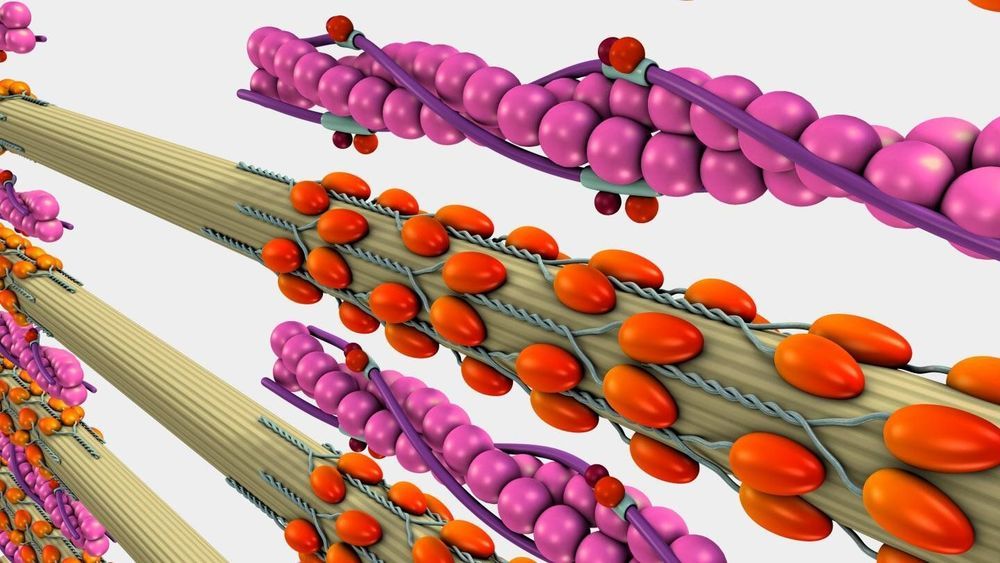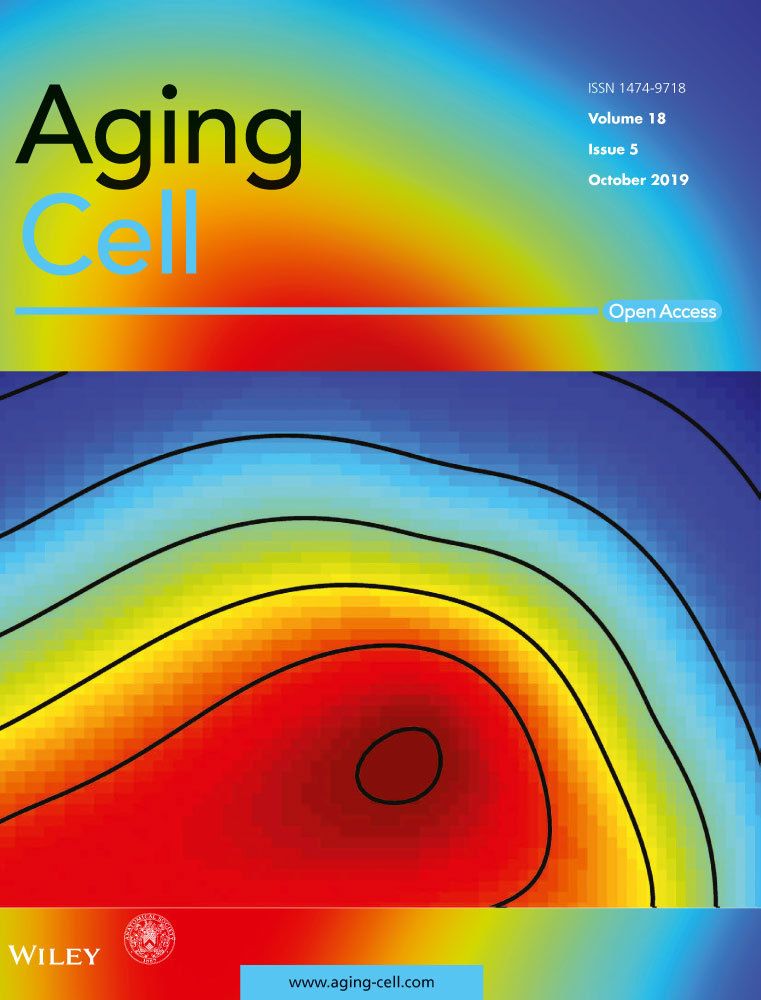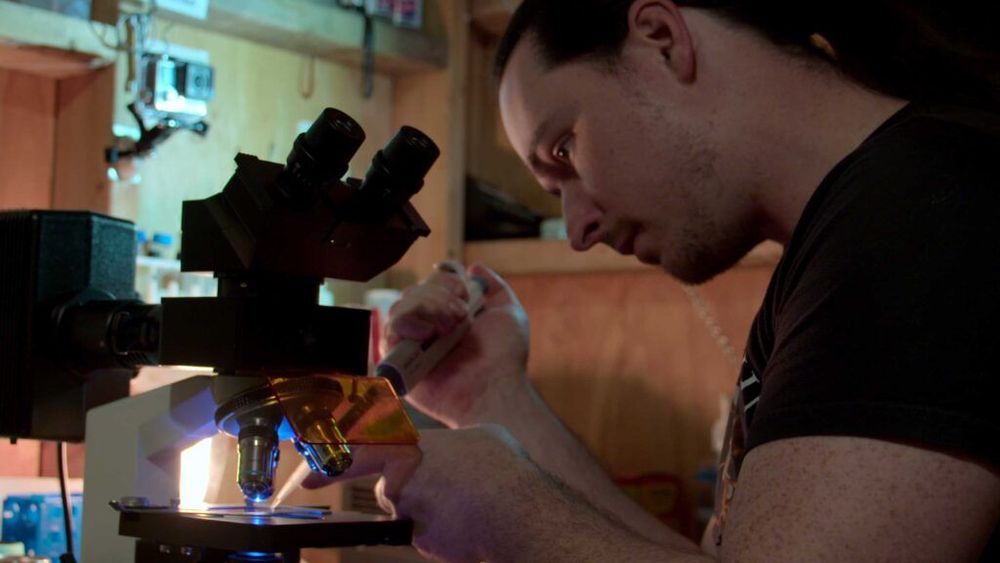Page 8230
Oct 19, 2019
Army bio-inspired theoretical research may make robots more effective on the future battlefield
Posted by Paul Battista in categories: military, particle physics, robotics/AI
In an effort to make robots more effective and versatile teammates for Soldiers in combat, Army researchers are on a mission to understand the value of the molecular living functionality of muscle, and the fundamental mechanics that would need to be replicated in order to artificially achieve the capabilities arising from the proteins responsible for muscle contraction.
Bionanomotors, like myosins that move along actin networks, are responsible for most methods of motion in all life forms. Thus, the development of artificial nanomotors could be game-changing in the field of robotics research.
Researchers from the U.S. Army Combat Capabilities Development Command’s Army Research Laboratory have been looking to identify a design that would allow the artificial nanomotor to take advantage of Brownian motion, the property of particles to agitatedly move simply because they are warm.
Oct 19, 2019
The universe might be full of Earth-like exoplanets, study suggests
Posted by Paul Battista in categories: chemistry, space
Earth-like exoplanets may be quite common in the universe, a new UCLA study suggests.
Scientists led by Alexandra Doyle, a University of California, Los Angeles (UCLA) graduate student of geochemistry and astrochemistry, came up with a new method to analyze the geochemistry of planets outside our solar system for the study, which was published in the journal Science this week.
“We have just raised the probability that many rocky planets are like the Earth and there’s a very large number of rocky planets in the universe,” co-author Edward Young, UCLA professor of geochemistry and cosmochemistry, said in a statement.
Oct 19, 2019
Downregulation of the inflammatory network in senescent fibroblasts and aging tissues of the long‐lived and cancer‐resistant subterranean wild rodent, Spalax
Posted by Paul Battista in categories: biotech/medical, life extension, neuroscience
The blind mole rat (Spalax) is a wild, long‐lived rodent that has evolved mechanisms to tolerate hypoxia and resist cancer. Previously, we demonstrated high DNA repair capacity and low DNA damage in Spalax fibroblasts following genotoxic stress compared with rats. Since the acquisition of senescence‐associated secretory phenotype (SASP) is a consequence of persistent DNA damage, we investigated whether cellular senescence in Spalax is accompanied by an inflammatory response. Spalax fibroblasts undergo replicative senescence (RS) and etoposide‐induced senescence (EIS), evidenced by an increased activity of senescence‐associated beta‐galactosidase (SA‐β‐Gal), growth arrest, and overexpression of p21, p16, and p53 mRNAs. Yet, unlike mouse and human fibroblasts, RS and EIS Spalax cells showed undetectable or decreased expression of the well‐known SASP factors: interleukin‐6 (IL6), IL8, IL1α, growth‐related oncogene alpha (GROα), SerpinB2, and intercellular adhesion molecule (ICAM‐1). Apparently, due to the efficient DNA repair in Spalax, senescent cells did not accumulate the DNA damage necessary for SASP activation. Conversely, Spalax can maintain DNA integrity during replicative or moderate genotoxic stress and limit pro‐inflammatory secretion. However, exposure to the conditioned medium of breast cancer cells MDA‐MB‐231 resulted in an increase in DNA damage, activation of the nuclear factor κB (NF‐κB) through nuclear translocation, and expression of inflammatory mediators in RS Spalax cells. Evaluation of SASP in aging Spalax brain and intestine confirmed downregulation of inflammatory‐related genes. These findings suggest a natural mechanism for alleviating the inflammatory response during cellular senescence and aging in Spalax, which can prevent age‐related chronic inflammation supporting healthy aging and longevity.
Oct 19, 2019
Mice with hyper-long telomeres show less metabolic aging and longer lifespans
Posted by Paul Battista in categories: biotech/medical, genetics, life extension
Short telomeres trigger age-related pathologies and shorter lifespans in mice and humans. In the past, we generated mouse embryonic (ES) cells with longer telomeres than normal (hyper-long telomeres) in the absence of genetic manipulations, which contributed to all mouse tissues. To address whether hyper-long telomeres have deleterious effects, we generated mice in which 100% of their cells are derived from hyper-long telomere ES cells. We observe that these mice have longer telomeres and less DNA damage with aging. Hyper-long telomere mice are lean and show low cholesterol and LDL levels, as well as improved glucose and insulin tolerance. Hyper-long telomere mice also have less incidence of cancer and an increased longevity. These findings demonstrate that longer telomeres than normal in a given species are not deleterious but instead, show beneficial effects.
Oct 19, 2019
Surprise Black Hole Discovery Could Explain How They Grew So Enormous in The Early Universe
Posted by Paul Battista in categories: cosmology, materials
In recent years, cosmologists peering back to the very dawn of our Universe have discovered something peculiar. A whole bunch of supermassive black holes — in a time thought way too early for such massive objects to have formed.
Exactly how they got to be so freaking huge so quickly is a heck of a puzzle — but a new surprise discovery might have delivered an answer. The disc of dust and gas around a supermassive black hole is moving in such a way that it’s slurping down material faster than it would normally.
That means it’s gaining mass faster than expected — which in turn could explain what happened in the earliest days of our Universe.
Oct 19, 2019
Chains of atoms move at lightning speed inside metals
Posted by Quinn Sena in categories: particle physics, space
A phenomenon that has previously been seen when researchers simulate the properties of planet cores at extreme pressures has now also been observed in pure titanium at atmospheric pressure. Chains of atoms dash around at lightning speeds inside the solid material.
“The phenomenon we have discovered changes the way we think about mass transport in metals. It explains properties of metals that we have, until now, not been able to understand. It’s too early to say what this means in practical terms, but the more we know about how materials function in different conditions, the better possibilities we have to develop materials with new or improved properties,” says Davide Sangiovanni, researcher in the Division of Theoretical Physics at LIU and principal author of an article that has been published in Physical Review Letters.
Oct 19, 2019
Blanket of light may give better quantum computers
Posted by Paul Battista in categories: computing, quantum physics
Quantum mechanics is one of the most successful theories of natural science, and although its predictions are often counterintuitive, not a single experiment has been conducted to date of which the theory has not been able to give an adequate description.
Along with colleagues at bigQ (Center for Macroscopic Quantum States—a Danish National Research Foundation Center of Excellence), center leader Prof. Ulrik Lund Andersen is working on understanding and utilizing macroscopic quantum effects.
“The prevailing view among researchers is that quantum mechanics is a universally valid theory and therefore also applicable in the macroscopic day-to-day world we normally live in. This also means that it should be possible to observe quantum phenomena on a large scale, and this is precisely what we strive to do in the Danish National Research Foundation Center of Excellence bigQ,” says Lund Andersen.
Oct 19, 2019
The ‘unbelievable journey’ of CRISPR, now on Netflix
Posted by Genevieve Klien in categories: bioengineering, biotech/medical, ethics, genetics
Mankind’s ability to edit the fabric of human life has led to scientific upheaval, global debate, and at least one international incident. Now, it’s coming to Netflix.
“Unnatural Selection,” a four-part docuseries debuting Friday, dissects the stories, science, and ethics behind genome editing, following academics, biohackers, and patients as they move through a brave new world made possible by technologies like CRISPR.
We recently spoke with co-directors Joe Egender and Leeor Kaufman about how the series came to be and how it frames the sprawling story of human genetic engineering. This transcript has been lightly edited for clarity.
Oct 19, 2019
Tesla Model Y: beautiful new bright red prototype spotted at Gigafactory 1
Posted by Genevieve Klien in categories: sustainability, transportation

Tesla is rolling out more Model Y prototypes for testing and we are getting to see the new electric crossover in new colors, including now a beautiful new bright red prototype spotted at Gigafactory 1.
Earlier this month, a Model Y prototype was spotted being tested around Tesla’s headquarters in Palo Alto and since then, there has been a more steady stream of Model Y sightings.
Continue reading “Tesla Model Y: beautiful new bright red prototype spotted at Gigafactory 1” »

















